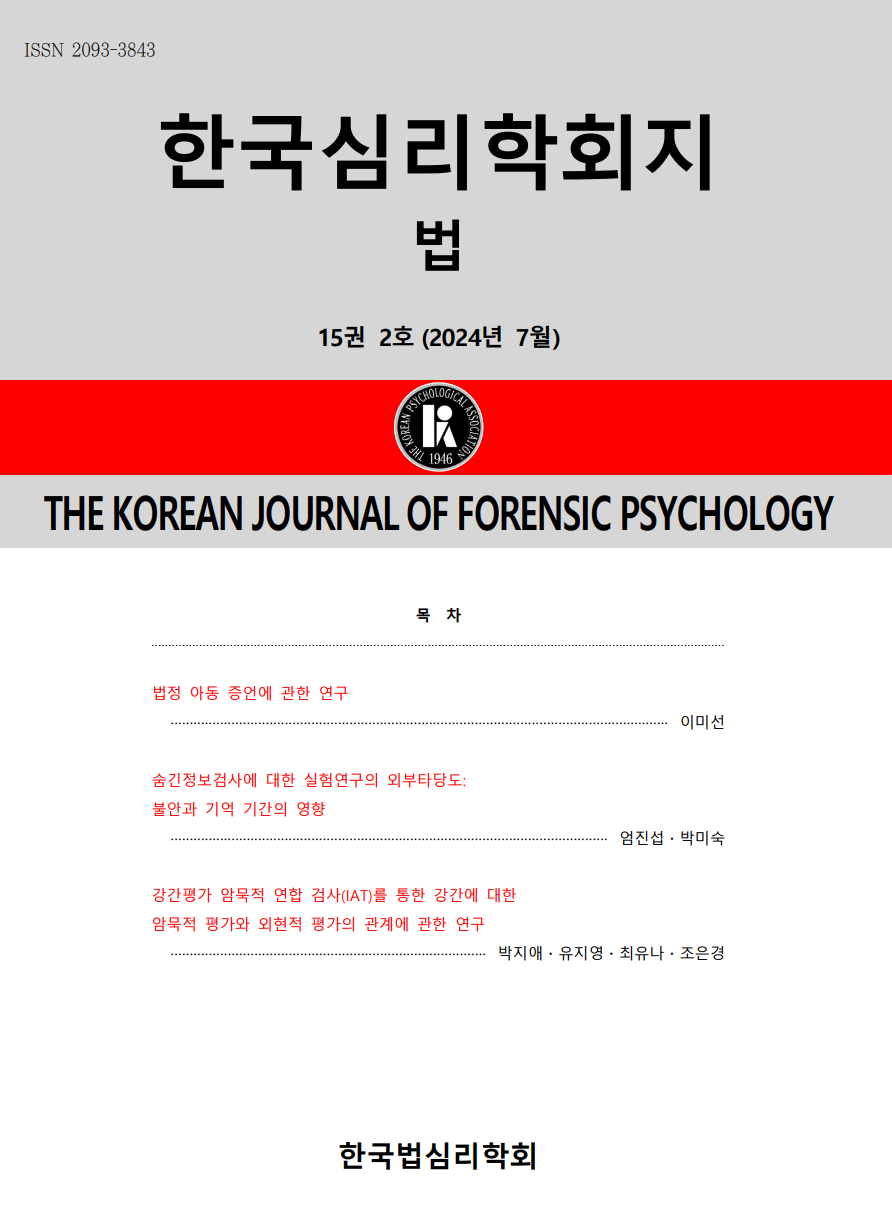open access
메뉴
open access
메뉴 ISSN : 2093-3843
ISSN : 2093-3843
Recent trends in the criminal cases without convincing evidence have shown to increase. Consequently, the demand for polygraph examinations to verify the statements offered by conflicting parties has been simultaneously growing. Yet, unfortunately, previous studies rarely focus on the factors that may influence the polygraph results which often proceed to affect legal decisions. Thus, this study compared polygraph test results with prosecutions and court decisions, and offered to provide comprehensive information on the factors related to polygraph, which have shown to influence the agreement rate between the polygraph results and legal decisions. The data used for this research was from examinations of 6,273 cases and 8,609 subjects; these tests were administered in the Korean prosecutors’ offices during 2009 to 2012. Results suggested that the likelihood of drawing a conclusive result differed as a function of the polygraph testing method; a conclusive result was more likely when examinations were done in the paired-testing method compared to the single-testing method. In terms of the overall agreement rate between the polygraph results and the prosecutors’ indictments, 78.6% were in agreement and this rate was significantly affected by the crime and the type of indictment. However, demographic factors such as sex, age and legal status did not influence the overall rate. The analysis for comparing the polygraph test results with the court decisions demonstrated that 83.6% were in agreement. More specifically, the rate of the examiners correctly judging the convicted suspects as guilty in the polygraph tests was as high as 90.8%. This study is the first to use a field data to investigate the factors that are related to polygraph and their effect on legal decisions. The findings will be a significant endeavor in promoting the accuracy of polygraph testing in legal procedure.
김병준 (2005). 거짓말탐지기의 이용과 법적문제. 수사연구, 23(8), 116-122.
김용승 (2012). 사기범죄 수사실무. 서울: 법무연수원
대검찰청 (2008). 2007년 종합 심사 분석. 서울: 대검찰청
대검찰청 (2014). 과학수사실무매뉴얼. 서울: 대검찰청
박광배 (2010). 법심리학. 서울: 학지사
박용철 (2013). 연구논문: 거짓말탐지기 검사 결과의 활용에 대한 소고. 형사정책, 25(3), 339-360.
박판규 (1999). 거짓말탐지검사의 효용과 한계. 형사정책연구.
박판규 (2003). 거짓말탐지검사. 서울: 삼우사.
심희기 (1999). 과학적 증거의 허용성과 신빙성. 형사법 연구, 12.
양동철 (2013). 진술서, 진술녹취서의 증거능력. 경희법학, 48(1), 433-468.
엄진섭, 지형기, 박광배 (2008). 폴리그라프 검사의 정확도 추정. 한국심리학회지: 문화및 사회문제, 14(4), 1-18.
이승현, 김지영, 최민영, 권수진, 이상한 (2012). 법과학을 적용한 형사사법의 선진화 방안 (3). 연구총서, 2012(11), 1-837.
이주락 (2007). 폴리그라프검사의 판단여부에영향을 미치는 요인에 관한 연구-경찰의교통사고조사를 중심으로. 한국경찰연구, 6(3), 31-58.
정재영, 김재홍, 김미영, 강민국, 지형기, 김기호, 이장한 (2010). 상반된 주장에 대한 폴리그래프 검사의 판별 정확성. 한국심리학회지: 사회 및 성격, 24(1), 1-10.
조은경 (2006). 폴리그래프검사의 타당성 및 행 동분석과의 상관성 연구. 2006 대검찰청정책연구 용역과제 최종보고서.
최효택, 김희송 (2005). 폴리그래프 검사-이론과실무. 서울: 나래P&P
한유화, 박광배 (2008). 범죄수사를 위한 거짓말탐지 검사(polygraph test)의 판정기준과정확성. 한국심리학회지: 문화 및 사회문제, 14(4), 103-117.
한유화, 박광배 (2009). 폴리그라프 비교질문검사 (comparison question technique: CQT) 기본 가정의 타당성에 대한 증거: 오류긍정비율. 한국심리학회지: 일반, 28(2), 471-484.
American Polygraph Association (2011). Metaanalytic survey of criterion accuracy of validated polygraph technique. Polygraph, 40(4), 195-305.
Barland, G. H., & Raskin, D. C. (1975). An evaluation of field techniques in detection of deception. Psychophysiology, 12(3), 321-330.
Ben-Shakhar, G. (1991). Clinical judgment and decision-making in CQT-polygraphy. Integrative Physiological and Behavioral Science, 26(3), 232-240.
Bersh, P. J. (1969). A validation study of polygraph examiner judgments. Journal of Applied Psychology, 53(5), 399.
Bradley, M. T., & Cullen, M. C. (1993). Polygraph lie detection on real events in a laboratory setting. Perceptual and motor skills, 76(3), 1051-1058.
Bradley, M. T., & Rettinger, J. (1992). Awareness of crime-relevant information and the Guilty Knowledge Test. Journal of Applied Psychology, 77(1), 55.
Buckley, J. P., & Senses, L. C. (1991). The Influence of Race and Gender on Blind Polygraph Charts Analyses. Polygraph, 20(4), 247-258.
Bull, R. (1988). What is the lie-detection test. The polygraph test: Lies, truth and science, 10-19.
Giesen, M., & Rollison, M. A. (1980). Guilty knowledge versus innocent associations: Effects of trait anxiety and stimulus context on skin conductance. Journal of Research in Personality, 14(1), 1-11.
Horvath, F. S., & Reid, J. E. (1971). The reliability of polygraph examiner diagnosis of truth and deception. The Journal of Criminal Law, Criminology, and Police Science, 276-281.
Matte, J. A., & Reuss, R. M. (1991). A study of the relative effectiveness of physiological data in field polygraph examinations. Polygraph, 21(1), 1-22.
Office of Technology Assessment. (1983). Scientific validity of polygraph testing: A research review and evalution - Technical Memo. Report No.:OTA-TM-H-15. Washington. DC.
Raskin, D. C., Barland, G., & Podlesny, J. A. (1978). Validity and reliability of detection of deception (Vol. 61): Department of Justice, Law Enforcement Assistance Administration, National Institute of Law Enforcement and Criminal Justice.
Raskin, D. C., & Hare, R. D. (1978). Psychopathy and detection of deception in a prison population. Psychophysiology, 15(2), 126-136.
Raskin, D. C., & Yuille, J. C. (1989). Problems in evaluating interviews of children in sexual abuse cases. Perspectives on children’s testimony, 184-207.
Reed, S. (1993). Subcultural report - Effects of examiner's and examinee's race on psychophysiological detection of deception outcome accuracy. Report DODPI94-R-0012. Department of Defense Polygraph Institute. Ft.
McClellan, AL., Waid, W. M., Orne, M. T., & Wilson, S. K. (1979). Effects of level of socialization on electrodermal detection of deception. Psychophysiology, 16(1), 15-22.